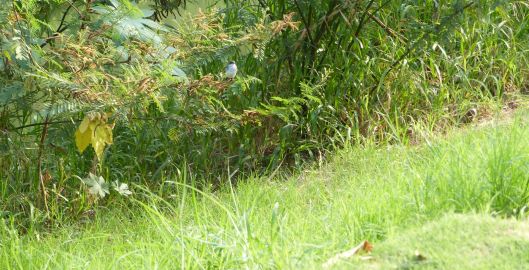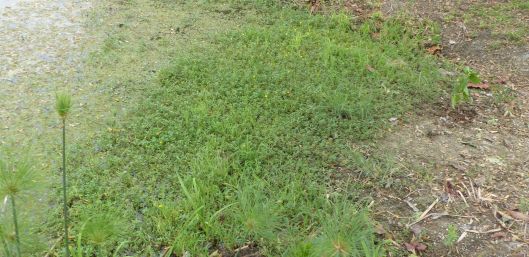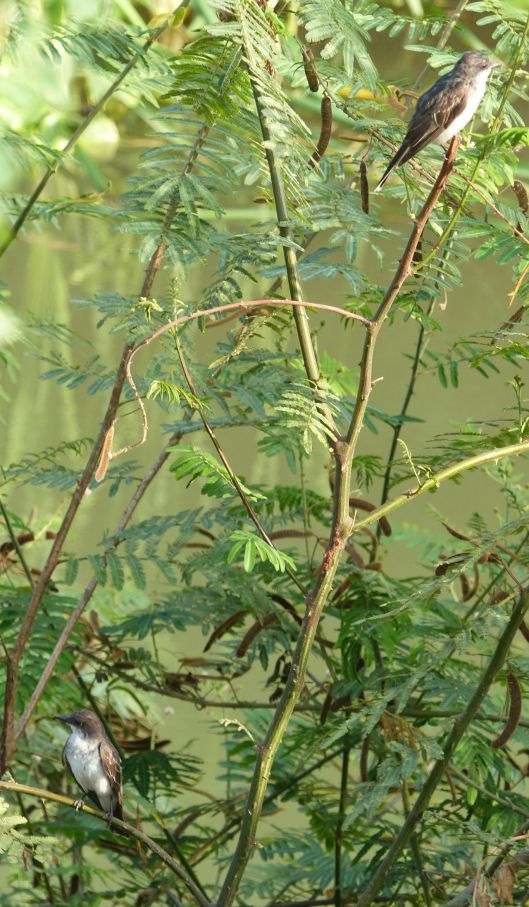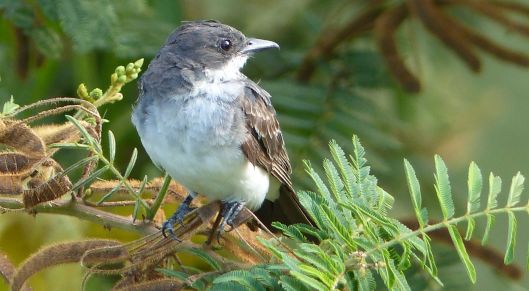Manabi Province/Ecuador – Are you house-bound/weather bound and wistful for a dose of nature? If so, take a cyber trip to the equator and go bird watching with me! It’s as if the birds take turns in presenting new surprise sightings!

Surprise migratory birds along Rio Portoviejo!

Parque las Vegas/Portoviejo Ecuador – Another migratory species has veered to Manabi Province instead of traditional vacation options. The first day these black and white birds appeared, I was without my camera. Joining a mixed flock of seedeaters, Saffron Finches, doves and Tropical Kingbirds, they dotted the unkempt edge of Rio Portoviejo, which borders the park. They seemed to be having an end-of-day gathering – or perhaps an early celebration for the end of 2020.
I thought, “Variable Seedeater” – but no, they were larger than seedeaters, and their behavior was like a flycatcher’s.
I thought, “Becard,” but no, the behavior was wrong.
I briefly considered, ‘Snowy-throated Kingbird,’ – but no, the coloration was all wrong.
It certainly wasn’t a Masked Tityra, with the right colors below but not on top.
I made a few sketches, but could only see the basic details – white throat and belly with contrasting dark/black upper areas.
A second brief glimpse would follow the next day around noon.
I often check on the lone Sora, which now claims a quiet corner of the pond as its hiding place. Throughout the day the petite bird forages back and forth for the little red ‘fruits’ that fall from the overhead trees. It sometimes cowers as close to the ground as possible when a gallinule approaches. Do you see the Sora in the image below?





Even when I watch it fade into its environment, it becomes invisible to my eyes. After the gallinules leave the area, the Sora re-appears and resumes foraging – or begins splashing as if to celebrate another hide-and-seek victory!


Two Eared Doves and one Sora
I often marvel at how small it is, and wonder if its body would fit into my cupped hand. The Eared Doves are larger than the Sora! For size-comparison, I placed my Fieldbook near the Sora’s typical path along the water. The Sora acknowledged and then completely ignored the book and allowed a photo session.

Saffron Finches, Parrot-billed Seedeaters and Eared Doves also prefer this shady area of the pond.

While watching the Sora, I peered to the treetops and found one lone stranger with the Scrub Blackbirds, Saffron Finches and Tropical Kingbirds. I took a hurried photo before the bird darted to another location.

The first photo – not good – of a mystery bird with an all-white belly and dark upper.
With no luck finding any more mystery birds, I returned home, worked on photos and then checked online for more information. Armed with research material and camera in hand, I returned to the park in the late afternoon.
“Eastern Kingbirds are blackish above and white below. The head is a darker black than the wings and back, and the black tail has a conspicuous white tip…They spend winters in South American forests, where they eat mainly fruit.” from Cornell Lab’s All About Birds

The map is extremely helpful in this Fieldbook for the Birds of Ecuador

…except that this map for the Eastern Kingbird shows that these birds are way off their normal route. Manabi Province is on the western side of the country.
As they were the day before, there were at least six along the river. These seemed to have an appetite for insects, and three allowed me to observe them from close range until they roosted – with mixed species – at the end of the day.


This one’s tail feathers are quite worn!

These mysterious birds might represent omens of hope!
Exhausting the camera’s battery, I enjoyed watching the various species interacting in a mostly-dead tree that I nicknamed ‘The Tree of Life.’ It might be unsightly to most humans, but it is a bird magnet.

13 birds – six species in this Riverside Tree of Life.
The next day I uploaded my checklist to eBird. As I expected, eBird tossed back a prompt for more information, as this species usually stays on the other side of the Andes.
Enjoy watching their migratory movements on eBird’s Abundance Map.
(If this is not an Eastern Kingbird, maybe someone can help with identification?)



This is a good time for birding in the park; many species are visible and highly active as our rainy season slowly begins. The mango trees are producing a bumper crop, to the delight of the Blue-gray Tanagers.

The endangered Grey-cheeked Parakeets have also graced us with their presence. This species reached the endangered status because of illegal capture for the caged-bird industry as well as the ongoing destruction of their native habitat.

Sometimes confused with the green and blue Pacific Parrotlet, the Grey-cheeked Parakeets have a splash of orange beneath their wings. The grey cheek, of course helps with identification if they stay still long enough for those details to show.

Pacific Parrotlet

The Parrot-billed Seedeater definitely deserves the rights to its name. These precious birds remain plentiful in the park – as long as the maintenance crew allows naturalized areas to thrive. On this day the birds were pulling the seed heads down, then holding them with one foot while eating the seeds!

The iguanas along the river maintain a relaxed attitude. They seemed to be completely neutral, illustrating that one can observe but not get caught up in the quarrels between others. They were almost regal at the end of the day as if to say, ‘Ah! We’ve earned the rights to be calm and relaxed.’
“Calm and relaxed” – I think that artists were given an extra dose of genes that help us to be calm and relaxed. My nephew Don once stated, “We make choices every day of our lives,” and he is right. I am grateful to have the ability to see my cup overflowing and not ‘half empty.’ I am grateful to have had an abundance of creative projects that keep me occupied and positive during this pandemic.
Spending time with nature also helps strengthen those traits, and I remain grateful that Nature continues to shower me with surprises.

Surprise Migratory Kingbirds along Rio Portoviejo!
As this year comes to an end, I am hopeful that 2021 will bring an abundance of positive experiences to everyone.

Eastern Kingbirds, Welcome to Manabi!
Happy New Year to all!
Love, Lisa

Hi Lisa- love your stories and photos and it so happens that rails are one of my favorite birds; I love all the skulker birds, so rails and warblers are my favs…its the thrill of the hunt I guess, and the prize is getting to see the bird! Your blogs and photos are so fabulous and it makes me want to BE there NOW! So fun that you document all the birds in the area so well. Scary start to 2021 tho, with the virus exploding. Gonna be a rotten year the way it looks. I worry about all the folks who already can’t make ends meet and feel horrible for the hospital workers that are working in such awful and dangerous conditions. And prob at least 50% of the increase i this country is because of a selfish narcissistic self-proclaimed germaphobe who had to convince his supporters not to wear masks, nor distance nor worry about the virus just to show his power. He’ll be the cause of so many deaths, so many crushed dreams etc for many years to come. This virus will go on into 2022 I bet, maybe 2023, 2024? where it could have been at least partially controlled had we had a leader who is not mentally ill and only concerned with himself. Makes me nauseous Do the E KIngbirds vocalize there at all? They breed here and make a noise like a zap of electric current…its a cool noise in case they make it there….. Thanks for the beauty you bring to all of uslove you- lee
Thank you for taking us bird watching Lisa. Such a huge variety as well. I had to smile when I saw the blue-grey tanager tucking into the mango, I have spotted our king parrots doing the same with our fruit. Hope you are keeping well and that your corner of the world is not too badly disrupted with the virus. Best wishes for 2021
Happy New Year to you, too, Lisa. Thanks for once again supplying us with a year of wonderful tales of birds, art, people and just, in general, the high points of your life in Ecuador. You do seem to have that gene for patience and calm….and we benefit. It’s obvious that you are still healthy and happy, as are we. Stay safe in this crazy time. Yay for 2021. May it bring a bit more tranquility than 2020. Love, Judy and Clyde
>
Sora to field book: Not stopping here. I already know all this stuff.
Hopefully Lisa to gallinule: Bugger off and leave the sora alone!
And happy new year to you!
You made me laugh – twice! Thank you, we need all the laughs possible – but yes, bugger off mean gallinules!
I think/hope that your latest post has loaded, so I can enjoy it in larger form back home. I repeat that it would be such a gift to view your series of sky pads in person…
Thanks so much Lisa! Happy to supply some silly humor.
Wonderful photos, such informational prose. Thank you, Miss Z and Happy New Year.
Happy New Year to you as well, Don! I hope that the end-of-year weather has not been too ugly, and that this new year brings us all positive experiences. Thanks as always for your support!
What a birding area! And with climate change, I wouldn’t be surprised if species were far out of their usual areas.
Yes, it’s beginning to look that way – with the oropendolas nesting again at Poza Honda, and Sora here (but I still worry abou the other two) and now the Eastern |Kingbirds. Makes me want to go to the park again – but a painting is taking forever and I really want to get it finished!
Happy New Year, Emilie!
Happy 2021 to you!
Happy New Year, Lisa! I always read your blog posts twice over before responding. The little Sora is such an adorable bird. I would love to see one in Jamaica (but there’s only a faint possibility of that). I have shared your posts with my friends at BirdLife Jamaica and BirdsCaribbean, so you may see more fans! PS We have the Grey Kingbird (or Petchary) as a summer visitor, and year-round we have the very boisterous Loggerhead Kingbirds.
Isn’t it funny how birds are attracted to particular trees? Our scrawny moringa tree is an example in our yard. I think they just like to hang out there, from big doves to tiny vervain hummingbirds!
Wishing you all the very best for the New Year. May it be happier!
It’s an embarrassment of riches, Lisa. 🙂 I have to say, the iguana always makes my eyes pop – I’m just not used to them, and I love their look. Have you been able to confirm the Eastern kingbid? I used to see them every summer back east, and as someone said, their call is very distinctive. But maybe yours were quiet. The notable things I remember are the slate-gray back, the white underside, and the uniquely-shaped head – almost a crest, but not a crest. They were all about perching somewhere where they could see insects and then flying out (in a swooping “sortie”) to catch them, then returning to the perch to eat. They have a fierceness and a look of pride that shows in their behavior. Good birding to you! (Maybe next year Lonely Little Sora will return with a posse).
The Sora and the field guide! That is a classic!
Lisa, I love your positive attitude about spending time in nature. Just taking time to sit and observe is a wonderful luxury, and I’m always surprised by what I hadn’t noticed before. Your bird photos are amazing, but I must admit the iguanas stole the show for me. What regal creatures. Wishing you a fabulous 2021. 🙂 ~Terri
Lisa, sorry I’m late to the bird watching party! But thanks for letting me tag along. It was enjoyable as always and it makes me happy every time I see a post from you. Good to know you’re healthy and I wish you a most happy, healthy, and blessed 2021!
janet